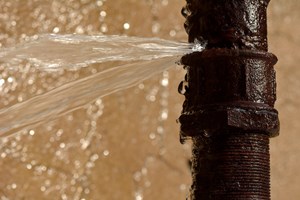Google and New Mexico partner to detect water leaks using satellite imagery
ALBUQUERQUE, N.M. (AP) — New Mexico is teaming up with Google to hunt for leaky water pipes using satellite imagery as the drought-stricken state prepares for a future in which growing demand puts more pressure on already dwindling drinking water supplies.
State officials made the announcement Tuesday as they rolled out a 50-year plan that includes nearly a dozen action items for tackling a problem faced by many communities in the western U.S., where climate change has resulted in warmer temperatures and widespread drought.
New Mexico is the first state to partner with Google for such an endeavor, state officials said, noting that the payoff could be significant in terms of curbing losses and saving municipalities and ratepayers money over the long term.
The water plan notes that some systems in New Mexico are losing anywhere from 40% to 70% of all treated drinking water because of breaks and leaks in old infrastructure.
The plan calls for using new technology and remote sensing techniques to conduct an inventory of water loss across more than 1,000 public water systems in the state this year. Aside from being able to detect leaks in real time, the information will help to prioritize repair and replacement projects, officials said.
Gov. Michelle Lujan Grisham, Native American leaders and other experts gathered at the state Capitol to provide an overview of the plan, which has been years in the making. Lujan Grisham, who had campaigned more than four years ago on creating a long-term plan to guide management of the finite resource, warned that New Mexico will likely have 25% less water available in five decades.
Lujan Grisham, who is entering her second term, praised residents for existing conservation efforts but said New Mexico has to do better and be more creative about tapping what she called “an ocean of brackish water.” That water, she said, can be used for industrial purposes so that businesses can continue to contribute to the state’s economy while limiting impacts on drinking water supplies.
She pointed to computer chip manufacturer Intel, which for years has been recycling the water it uses at its factory near Albuquerque.
“We don’t need to make that choice between safe drinking water and your business,” the governor said. “We have the chance here to do both and that’s exactly the path we’re on.”
Some environmental groups have raised concerns about Lujan Grisham’s plan to underwrite development of a strategic new source of water by buying treated water that originates from the used, salty byproducts of oil and natural gas drilling. They contend that it will help to encourage more fossil fuel development in what is already the No. 2 producing state in the U.S.
Water from oil and gas drilling can be viable for certain applications, and all industries — including oil and gas — have to reduce their overall use and protect current supplies, the governor said Tuesday.
State lawmakers who attended the governor’s news conference vowed that the budget being hashed out during the current legislative session will include more money for water infrastructure projects. One proposal calls for funneling another $100 million to the state water board to disperse for shovel-ready projects.
In 2018, New Mexico rolled out a water plan that included details about policies at the time, historical legal cases and regional water plans. While it offered an inventory of the state’s needs, critics said it fell short of laying out a concrete path for how to solve New Mexico’s water problems.
Aside from addressing antiquated infrastructure, New Mexico’s new plan calls for cleaning up contaminated groundwater, spurring investments in desalination and wastewater treatment, and improving mapping and monitoring of surface and groundwater sources.
Rebecca Roose, the governor’s senior infrastructure adviser, described the plan as a set of guideposts that can help the state keep moving forward on water policy and infrastructure investments.
“We see a path forward around our water conservation, around making sure we have the water availability that we need — driven by science — cleaning up and protecting our water and watersheds,” she said. “I think this is going to live and evolve and grow.”
Related News
From Archive

- DeLa Express seeks FERC approval for Permian-to-Louisiana gas pipeline project
- OSHA penalizes Houston contractor over safety violations resulting in worker's death
- Fiber infrastructure has no known expiration date, Fiber Broadband Association research concludes
- Nevada OSHA fines Elon Musk's Boring Company over safety violations in Vegas tunnel project
- Damage prevention and safety: Turning awareness into action
- Ditch Witch 1030
- Michigan lawmakers introduce bills to create septic codes throughout the state
- Indiana American Water to gain 8,000 water customers with Silver Creek Water acquisition
- Arkansas governor allocates $42 million for water infrastructure projects
- Federal judge finds Flint, Mich, in contempt over lead water pipe crisis




Comments